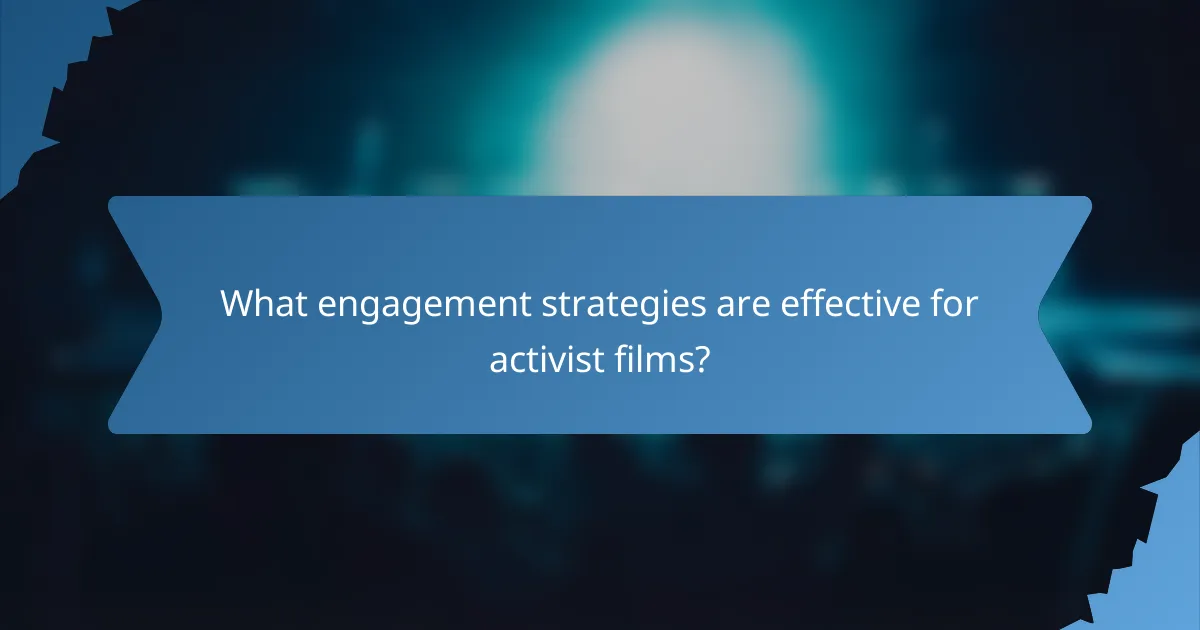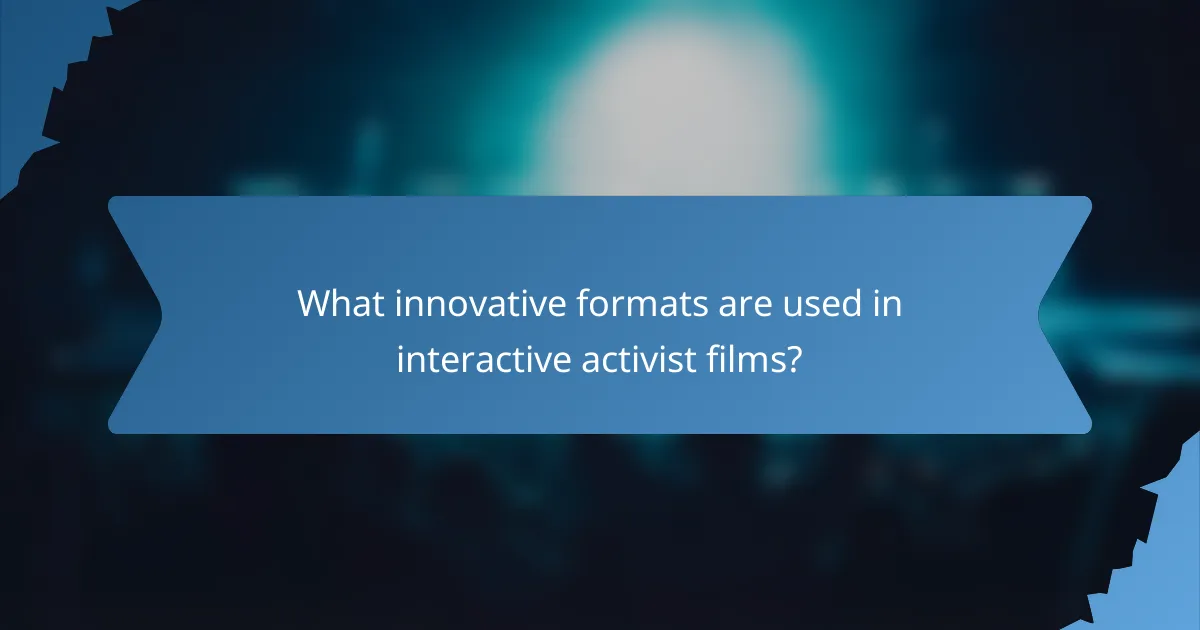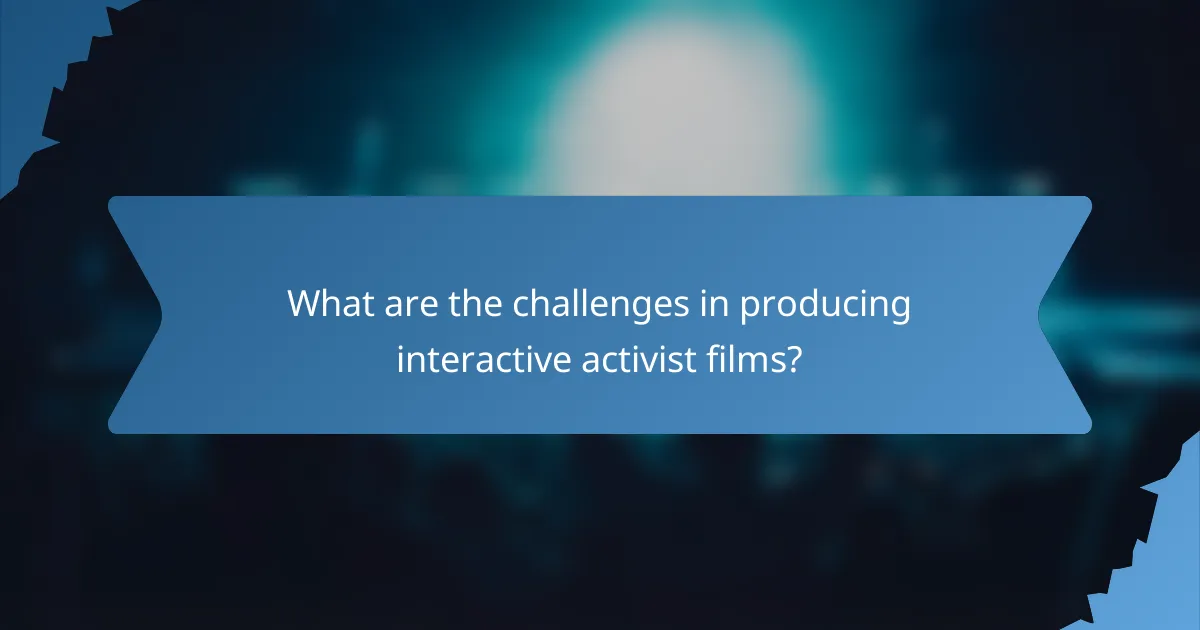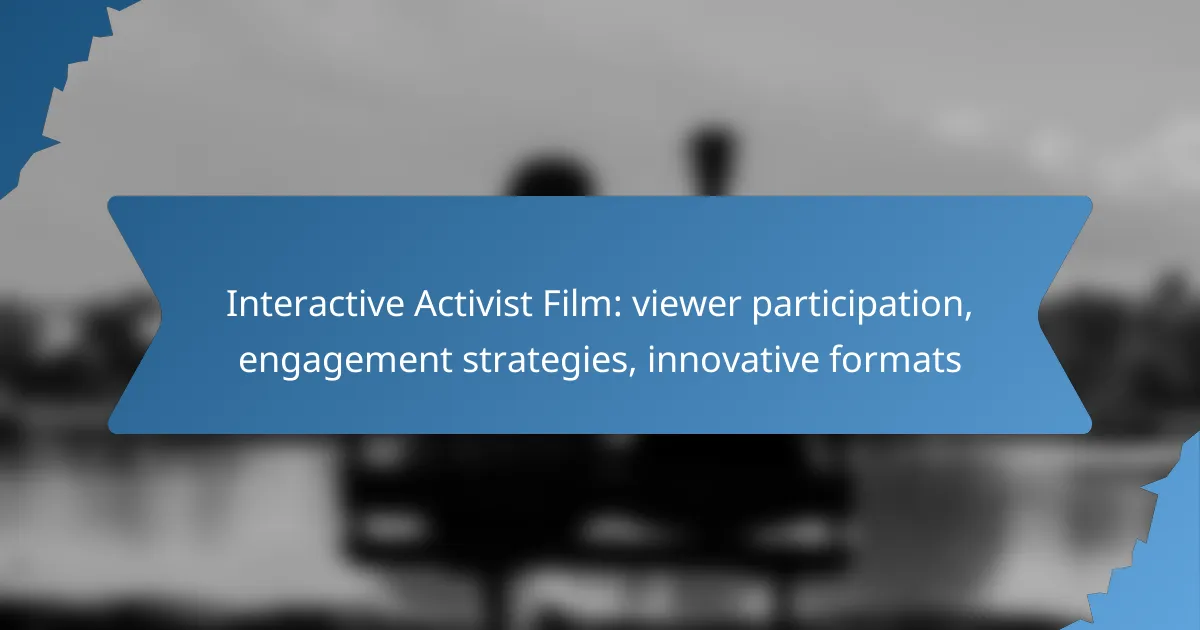Interactive activist films leverage viewer participation to create a deeper emotional connection with the audience, transforming passive viewers into active participants. By employing innovative formats and engagement strategies, these films foster community and drive action on critical social issues. Through immersive experiences, they invite audiences to contribute meaningfully to the narratives and themes explored, amplifying the impact of the activism they represent.

How can viewer participation enhance interactive activist films?
Viewer participation can significantly enhance interactive activist films by fostering a deeper connection between the audience and the content. Engaging viewers not only amplifies their emotional investment but also encourages active involvement in the issues presented.
Increased emotional connection
When viewers participate in interactive activist films, they often develop a stronger emotional bond with the subject matter. This connection can be achieved through personalized storytelling, where the audience’s choices influence the narrative, making them feel like integral parts of the story.
For example, films that allow viewers to select different paths or outcomes can evoke empathy and understanding, as participants experience the consequences of their choices. This immersive experience can lead to heightened awareness and motivation to act on the issues depicted.
Real-time feedback mechanisms
Incorporating real-time feedback mechanisms allows viewers to express their opinions and reactions instantly, creating a dynamic dialogue between the film and its audience. This can be facilitated through polls, chats, or social media integration, enabling participants to share their thoughts as they engage with the content.
Such mechanisms not only enhance viewer engagement but also provide filmmakers with valuable insights into audience perceptions. This feedback can inform future projects and help tailor content to better resonate with viewers’ values and concerns.
Community building through shared experiences
Interactive activist films can foster community building by creating shared experiences among viewers. When participants engage collectively, whether in a screening or through online platforms, they can connect over common interests and goals related to the film’s themes.
Organizing discussions or forums post-viewing can further strengthen these connections, allowing participants to collaborate on actions or initiatives inspired by the film. This sense of community can empower individuals to work together towards social change, amplifying the film’s impact beyond the screen.

What engagement strategies are effective for activist films?
Effective engagement strategies for activist films include interactive elements that encourage viewer participation and foster a sense of community. These strategies can enhance the emotional impact of the film and drive action among audiences.
Gamification techniques
Gamification techniques involve incorporating game-like elements into the viewing experience to motivate and engage audiences. This can include challenges, rewards, or interactive quizzes related to the film’s themes, encouraging viewers to participate actively rather than passively.
For example, a film about climate change might include a challenge where viewers track their carbon footprint and compete with others. This not only makes the experience more engaging but also reinforces the film’s message.
Social media integration
Social media integration allows viewers to share their thoughts and experiences related to the film in real-time. By creating hashtags or dedicated social media pages, filmmakers can encourage discussions and amplify the film’s reach.
For instance, a documentary on social justice could prompt viewers to share their personal stories using a specific hashtag, creating a community dialogue that extends beyond the film itself. This approach can significantly enhance viewer engagement and foster a sense of belonging.
Live Q&A sessions
Live Q&A sessions provide an opportunity for viewers to interact directly with filmmakers, activists, or experts after the screening. This format allows audiences to ask questions, share insights, and deepen their understanding of the film’s subject matter.
Organizing these sessions via platforms like Zoom or social media can make them accessible to a broader audience. Offering incentives, such as exclusive content or merchandise, can further encourage participation and enhance the overall engagement experience.

What innovative formats are used in interactive activist films?
Interactive activist films utilize various innovative formats to enhance viewer participation and engagement. These formats create immersive experiences that encourage audiences to actively contribute to the narrative and themes presented in the films.
Virtual reality experiences
Virtual reality (VR) experiences in interactive activist films transport viewers into a fully immersive environment where they can engage with the story on a personal level. Users often wear VR headsets that allow them to explore different scenarios and perspectives related to social issues, making the experience more impactful.
For example, a VR film about climate change might let viewers walk through a virtual forest, witnessing the effects of deforestation firsthand. This format can significantly enhance empathy and understanding, as participants feel as if they are part of the narrative.
Choose-your-own-adventure narratives
Choose-your-own-adventure narratives empower viewers to make decisions that influence the storyline, creating a personalized viewing experience. This format allows audiences to explore various outcomes based on their choices, which can reflect the complexities of real-world issues.
For instance, a film addressing social justice might present viewers with scenarios where they must choose how to respond to a crisis, leading to different endings based on their decisions. This interactivity encourages deeper engagement and reflection on the consequences of their choices.
Augmented reality applications
Augmented reality (AR) applications overlay digital information onto the real world, enhancing the viewer’s experience with interactive elements. Through smartphones or AR glasses, users can access additional content, such as statistics, personal stories, or calls to action, while watching the film.
An example of AR in activist films could be a documentary on human rights, where viewers can scan specific scenes to reveal more context or related data. This format not only enriches the narrative but also encourages viewers to take action by providing them with resources and information in real-time.

What are the prerequisites for creating interactive activist films?
Creating interactive activist films requires a solid understanding of audience engagement and technical skills in multimedia production. These elements are crucial for crafting experiences that resonate with viewers and encourage their active participation.
Understanding audience demographics
Knowing your audience demographics is essential for tailoring content that effectively engages viewers. Factors such as age, cultural background, and interests influence how individuals interact with films, making it vital to conduct thorough research before production.
Utilize surveys, social media analytics, and focus groups to gather insights about your target audience. This information can guide decisions on themes, narratives, and interactive elements that will resonate most with your viewers.
Technical skills in multimedia production
Proficiency in multimedia production is necessary to create compelling interactive activist films. This includes skills in video editing, sound design, and interactive software development, which are crucial for producing high-quality content that captivates and engages audiences.
Familiarize yourself with tools like Adobe Premiere Pro for editing, Unity or Twine for interactive elements, and sound editing software such as Audacity. Consider taking online courses or workshops to enhance these skills, ensuring that your production meets industry standards.

How do interactive activist films compare to traditional formats?
Interactive activist films differ from traditional formats by actively involving viewers in the narrative, fostering deeper engagement and personal investment. This participatory approach not only enhances viewer experience but also amplifies the film’s message and impact.
Higher viewer engagement rates
Interactive activist films typically achieve higher viewer engagement rates compared to traditional films. By allowing audiences to make choices or contribute to the storyline, these films keep viewers actively involved, which can lead to longer viewing times and greater emotional connection.
For example, platforms that incorporate decision-making elements or real-time feedback often see engagement levels increase by significant margins, sometimes reaching upwards of 50% more interaction than standard formats. This engagement can be crucial for mobilizing support for social causes.
More impactful storytelling
The storytelling in interactive activist films is often more impactful due to its ability to personalize the viewer’s experience. By allowing viewers to explore different perspectives or outcomes, these films can create a more profound emotional resonance, making the messages more memorable.
Consider films that allow users to navigate through various narratives based on their choices; this format can lead to a deeper understanding of complex social issues. By engaging viewers in this way, filmmakers can effectively highlight the urgency of their causes and inspire action.

What are the challenges in producing interactive activist films?
Producing interactive activist films involves several challenges that can hinder their effectiveness and reach. Key issues include technical limitations, funding constraints, and audience accessibility, each requiring careful consideration during the production process.
Technical limitations
Technical limitations can significantly impact the production of interactive activist films. These films often rely on advanced technology for viewer engagement, which may not be readily available or affordable for all creators. Issues such as software compatibility, internet bandwidth, and device compatibility can restrict audience participation.
Moreover, maintaining a seamless user experience is crucial. Filmmakers must ensure that interactive elements do not detract from the narrative. Testing across various platforms and devices is essential to identify and resolve potential technical glitches before release.
Funding and resource allocation
Securing adequate funding for interactive activist films can be challenging, as these projects often require more resources than traditional films. Budgeting for technology, skilled personnel, and marketing can strain limited financial resources. Filmmakers should consider crowdfunding, grants, or partnerships with organizations that align with their cause to alleviate financial pressure.
Effective resource allocation is critical to maximize impact. Prioritizing essential elements, such as high-quality production and engaging interactive features, can help ensure that the film resonates with its audience while staying within budget constraints.
Audience accessibility issues
Audience accessibility is a significant challenge for interactive activist films, as not all viewers may have the necessary technology or skills to engage fully. Factors such as socioeconomic status, age, and digital literacy can affect participation rates. Filmmakers should strive to create inclusive experiences that cater to diverse audiences.
Implementing features like subtitles, audio descriptions, and user-friendly interfaces can enhance accessibility. Additionally, providing alternative viewing options, such as offline access or simplified versions, can help reach a broader audience and ensure that the film’s message is effectively communicated.
